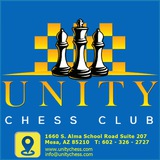In the game, there occurred 28...Rxc4 29.bxc4 Bh4 30.Kf2 Qxc4 (on 30...Rg5, there follows 31.f4 – this is where we see the excellent position of the queen at e3!) 31.Qd4 Qxc2+ 32.Rd2 Qc5 – the endgame looks equal and ended in a draw.
Black wins easily after 29.Qe2 Rxc4 30.bxc4 Bh4 31.Kf2 Rg5 – there is not the move f3-f4, and the Ng3 is simply lost.
Taking with the king allows the black queen to be included in the attack with tempo: 31.Kxd1 Qd8+ 32.Ke1 Qd4 33.Rg2 Bf4 34.Nf1 Rh1 – Black completely dominates, and has the irresistible threat of 35...Kf8, followed by 36...Bh3.
In this case, the zwischenzug helps Black equalise.
A) 13...cxd5?! 14.Bxg7 Kxg7 15.bxc4+=
B) 13...Qd6?! 14.Bxg7 Kxg7 15.bxc4+=
A) 13...cxd5?! 14.Bxg7 Kxg7 15.bxc4+=
B) 13...Qd6?! 14.Bxg7 Kxg7 15.bxc4+=
Draw, because the variation 19...Qxe2 20.Rxe7 Qxa2 21.Qxb7 Rab8 22.Qxa7 Qxa7 23.Rxa7 Rxb3, leads to a complete elimination of the fighting forces.
Unity Chess Club
Mateusz Bartel 2627 Pentala Harikrishna 2672 Germany Bundesliga 2011/12 White to move
White is to move, and Black has a knight under attack.
It turns out that we can first attack the queen, creating in the process the deadly threat 18.Qxc4+. In the game, there followed 17.Qxf5 Qd5 18.Qf3 Qxf3 19.Nxf3 Bf6, with Black having sufficient compensation for the pawn. After:
Thanks to the pin on the bishop, the c4-pawn is lost as well. White is winning.
